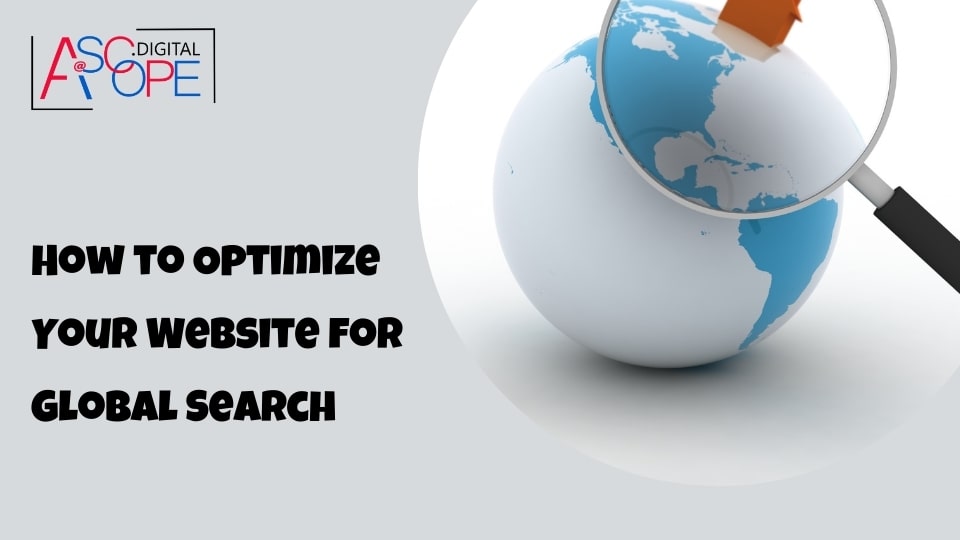In today’s interconnected world, optimizing your website for global search is essential for reaching international audiences and expanding your market presence. As more businesses go digital, the competition for online visibility intensifies. International SEO (Search Engine Optimization) ensures your website is accessible and appealing to users across different countries and languages. This comprehensive guide will provide you with actionable steps to optimize your website for global search, helping you attract and engage a diverse audience.
Understanding International SEO

International SEO involves optimizing your website so that search engines can identify which countries you want to target and which languages you use for business. It’s a multifaceted strategy that goes beyond standard SEO practices, focusing on global reach and user experience. Successful international SEO requires understanding the cultural, linguistic, and technical aspects of the target markets.
Conducting Market Research
Before diving into the technical aspects, it’s crucial to conduct thorough market research. Identify the countries where you want to expand and understand the local search behavior. Tools like Google Analytics, Google Trends, and market research reports can provide valuable insights into which regions have the highest demand for your products or services. Analyze your competitors in these markets to understand their strategies and identify gaps you can fill.
Choosing the Right Domain Strategy
Selecting the appropriate domain strategy is a critical step in international SEO. There are three primary options:
- Country Code Top-Level Domain (ccTLD): This involves using country-specific domains, such as .uk for the United Kingdom or .de for Germany. ccTLDs clearly signal to search engines and users that your website is tailored for a specific country. However, managing multiple ccTLDs can be resource-intensive.
- Subdomains: Using subdomains (e.g., de.yoursite.com) allows you to create country-specific versions of your website while keeping everything under a single domain. This approach is easier to manage than multiple ccTLDs but may not convey the same level of localization.
- Subdirectories: With subdirectories (e.g., yoursite.com/de/), you maintain a single domain with folders for each country. This method is the easiest to manage and consolidates SEO efforts, but it may not be as strong a signal of localization as ccTLDs.
Implementing Hreflang Tags
Hreflang tags are essential for indicating the language and geographical targeting of a webpage. These tags help search engines understand which version of your content to serve to users in different regions. Implementing hreflang tags correctly involves specifying language and regional codes in the HTML of each page. For instance, use <link rel="alternate" href="http://example.com/de/" hreflang="de"/> to target German-speaking users.
Translating and Localizing Content
Translation and localization are fundamental to international SEO. While translation converts text from one language to another, localization adapts content to the cultural and contextual nuances of the target audience. This includes adjusting idioms, measurements, dates, and images to resonate with local users. Invest in professional translation services or native-speaking content creators to ensure accuracy and cultural relevance.
Creating Localized Keyword Strategies
Keyword research is a cornerstone of SEO, and it’s equally important in international SEO. Use tools like Google Keyword Planner, Ahrefs, or SEMrush to identify keywords relevant to your target markets. Consider local search behavior and language variations. For instance, a keyword popular in the UK might have a different search volume or intent in Australia. Create keyword lists for each market and integrate them naturally into your localized content.
Optimizing Technical SEO
Technical SEO involves optimizing your website’s infrastructure to improve its crawlability, indexability, and user experience. For international SEO, pay special attention to:
- Site Speed: Ensure fast loading times for users in different regions. Use Content Delivery Networks (CDNs) to distribute your site’s content across various geographical locations, reducing latency.
- Mobile Friendliness: Mobile optimization is crucial as mobile search is prevalent worldwide. Implement responsive design and ensure your site performs well on all devices.
- Structured Data Markup: Use structured data to enhance search engine understanding of your content. Implement schema markup for local business, products, reviews, and other relevant data.
Managing Multilingual Websites

Managing multilingual websites requires careful planning and execution. Use Content Management Systems (CMS) that support multilingual content, such as WordPress with WPML or Drupal. Ensure your URLs, meta tags, and content are appropriately translated and localized. Create a clear site structure that makes it easy for users and search engines to navigate between different language versions.
Building Local Backlinks
Backlinks remain a significant ranking factor in SEO. For international SEO, focus on acquiring backlinks from reputable local websites in your target markets. This can include local news sites, blogs, industry directories, and partner websites. Building local backlinks not only boosts your site’s authority but also signals to search engines that your content is relevant to a specific region.
Utilizing Google Search Console and Analytics
Leverage Google Search Console and Google Analytics to monitor your international SEO performance. Use these tools to track organic traffic, search queries, click-through rates, and other key metrics for each country. Identify pages that perform well and those that need improvement. Regularly analyze user behavior to refine your strategies and ensure your website meets the needs of your global audience.
Implementing Geo-Targeting
Geo-targeting involves tailoring your content and marketing efforts to specific geographical locations. Use geo-targeting tools to deliver personalized content, promotions, and advertisements to users based on their location. This can enhance user experience and increase engagement. Additionally, use local languages, currencies, and contact information to build trust and credibility with your international audience.
Monitoring and Adapting to Algorithm Changes
Search engine algorithms are constantly evolving, and international SEO requires staying updated with these changes. Follow industry blogs, forums, and official announcements from search engines like Google and Bing. Monitor your website’s performance and be prepared to adapt your strategies in response to algorithm updates. Regularly audit your site to ensure it adheres to the latest SEO best practices.
Utilizing Social Media and Local Directories
Social media platforms and local directories can significantly boost your international SEO efforts. Create and maintain active profiles on popular social media platforms in your target markets. Engage with local communities, share relevant content, and participate in conversations to increase brand visibility. Additionally, list your business on local directories and review sites to enhance your online presence and credibility.
Providing Local Customer Support
Offering local customer support is crucial for building trust with your international audience. Provide customer service in the local language and during local business hours. Use local phone numbers, email addresses, and chat services to make it easy for customers to reach you. A responsive and culturally aware customer support team can significantly enhance user satisfaction and loyalty.
Leveraging Paid Advertising
Paid advertising can complement your international SEO efforts by driving targeted traffic to your website. Use platforms like Google Ads, Facebook Ads, and LinkedIn Ads to create campaigns tailored to specific regions. Set up geo-targeted ads and use localized ad copy to resonate with local audiences. Monitor the performance of your campaigns and adjust your strategies based on the results.
Case Studies and Success Stories
Including case studies and success stories in your international SEO strategy can build credibility and showcase your expertise. Highlight examples of businesses that have successfully expanded into new markets using international SEO. Share their challenges, strategies, and results to provide practical insights and inspire confidence in your audience.
Monitoring and Analyzing Performance
Once your website is optimized for global search, it’s crucial to continuously monitor and analyze its performance. Utilize tools such as Google Analytics and Search Console to track your website’s traffic, user behavior, and conversion rates. By analyzing this data, you can identify which strategies are working and which need improvement. Additionally, it’s important to pay attention to local search trends and user preferences, as these can vary significantly from one region to another.
Regularly reviewing your website’s performance allows you to make data-driven decisions that enhance user experience and search visibility. Implementing necessary adjustments based on analytical insights will ensure that your website remains competitive in the global market. Thus, improving traffic and sales for your website. Read more on the other reasons why your website isn’t getting traffic. By staying proactive and adaptable, you can maximize the benefits of your global SEO efforts.
Conclusion
Optimizing your website for global search is a complex but rewarding endeavor. By understanding the nuances of international SEO, conducting thorough market research, and implementing localized strategies, you can effectively reach and engage a diverse audience. Remember that international SEO is an ongoing process that requires continuous monitoring, adaptation, and improvement. Stay updated with the latest trends, tools, and best practices to maintain your competitive edge in the global market.
International SEO is a powerful tool for businesses looking to expand their reach and attract customers from around the world. By following the strategies outlined in this guide, you can optimize your website for global search and achieve long-term success in international markets. Invest in the necessary resources, stay committed to continuous improvement, and watch your global presence grow.


